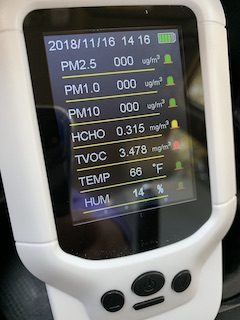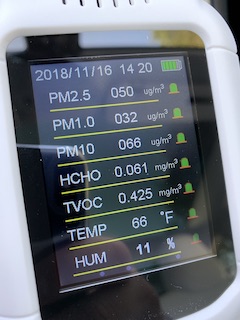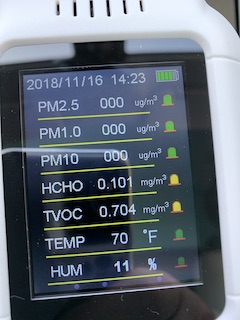Lots of wildfires in California lately and over 100 in the Santa Cruz area this year so they’ve closed many of the county parks to try to reduce the risk. This one a couple of weeks ago (the Rincon fire) was quite visible from my place but happily they were able to get it under control in a couple of days:
After seeing someone test the air filtration of Tesla’s Model X and its “biodefense mode” against the heavy smoke we’re getting from our wildfires this month, I decided to pick up an inexpensive air quality sensor to test my home’s air as well as my Model 3’s more mundane filtration system. (The Model 3 doesn’t have the Model X’s fancy “biodefense mode” or huge HEPA filters.)
With the PM2.5 sensor reading 150 μg/m3 (unhealthy) in the San Jose area (due to smoke from the Camp Fire that burned through Paradise, CA), I found that the Tesla Model 3’s air filter would bring things down to the 20’s in the cabin in just a few minutes when recycle air was turned on. Later, I stopped and made a video to record it falling from 135 to 5 μg/m3 in less than 10 minutes. It climbed back up to the 80’s pretty quickly though when I turned off recycle air and let it bring in fresh air:
This video was even picked up by Teslarati (“Model 3 protects owner…“) and re-tweeted by Elon.
Hi, Elon! But they didn’t pick up on my follow-up test to compare the Tesla to a Toyota:
Comparison with Toyota RAV4 EV
I decided to repeat the test with my 2013 Toyota RAV4 EV. This time the starting air quality wasn’t nearly as bad as my initial test but both the Tesla and the Toyota were able to filter the cabin down to a reading of zero from a start of 50 μg/m3 with recycle air turned on. At full fan speed, the RAV4 took about 10 minutes and the Model 3 was able to do it in about 3-4 minutes.
With recycle air turned off (fresh air intake on), the PM2.5 reading in both cars climbed up again. The Tesla was able to hold it around the low to mid 30’s but the RAV4 went up to essentially the outside reading of 50 μg/m3 again. So the Model 3’s system does work better.
One other thing of note is that the RAV4 ended up with a much higher concentration of TVOC (total volatile organic compounds), even though the vehicle is five years old. Presumably this is off-gassing of some of the materials in the cabin.Oh, and I forgot to turn off A/C in the RAV4 for the test – hence the temperature drop.
Here’s more detail in screenshots – RAV4 start and finish with recycle on:


Model 3 start and finish with recycle on:


On a subsequent four-hour drive to Tahoe in the Model 3, I encountered much worse air along the way (San Jose, Central Valley, Sacramento, etc). I’d guess the PM2.5 count was easily at least 150 μg/m3 and probably much higher in places, but I avoided opening the windows to test it. I kept the air on recycle and saw that the particle count held down around 20 but sometimes climb to the 30’s. Not bad, given how bad it was outside.
If you’re interested in buying a Tesla, using someone’s referral link will give you a discount (the amount varies over the years) and grants redeemable credits to the person who referred you. Here’s my Tesla referral link.
0 comments